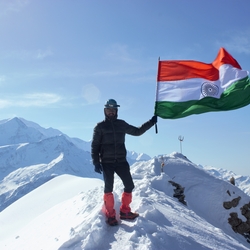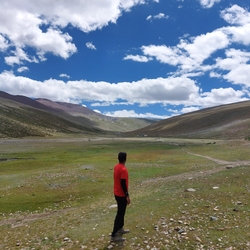Nestled in the Garhwal Himalayan Range of Uttarakhand, Har Ki Dun is one of the most sought after treks of India and not without reason. Set at a height of 3500 meters, the trail takes you through ancient villages along the Supin River all the while treating you to glorious views of prominent snow-capped peaks around.

In this article, we discuss who the Har Ki Dun Trek is meant for along with the gear and skills one will need to traverse this beauty of a trail enjoyably.
Difficulty level of the trek:
Har Ki Dun is a level 4 trek on the Bikat Rating Scale.
About the BRS: The Bikat Rating Scale rates the difficulty level of all treks and expeditions in our portfolio after taking into account their geographical and climatic conditions.
According to this scale, if you are a beginner who is unsure of your fitness level and don’t know what to expect on a trek, a trek rated one will be a good place to start.
If you liked your very first trekking experience and are looking to test your limits next, the treks rated 2 or 3 will do the job for you.
A beginner who is sure of their fitness level on the other hand is welcome to skip the first two levels and directly start with one of the treks rated 3.
From 4 onwards, the rules change a little. It is mandatory to have trekking experience of the previous level to participate in the next level.
The trails of Har Ki Dun
On the Har Ki Dun trail, you will be trekking a minimum of 10 kms every day. It takes anywhere between 5-7 hours to cover the distance depending on the nature of the terrain.
The trek begins at the quaint village of Sankri which is at an altitude of 1900 M. All trekkers will be required to report here on the first day.
On the second day, we will be driving to the rustic village of Taluka. The trekking trail starts here, winding gently along the right hand side of the Supin River. Today, you will be covering a total of 12 kms. The first five kilometres are gradual with easy ascents and descents. The section after this stretch turns steeper.

5 to 6 hours of hiking will eventually bring you to the campsite for the day, the ancient village of Seema. The altitude at Seema is 2,500 meters high and the temperatures tend to drop till -5 at night times. So please ensure you layer appropriately.
On day 3, you will be trekking to the Kalkattiyadhaar Village which is another 10 kms away. It takes 5-6 hours to reach here. The nature of the trail changes en-route. Since you will be gaining an altitude of 500M, there will be more ascents on the way. These efforts, however, will be more than rewarded for by breath-taking views of the Black Peak mountain, Bugyal Devsu mountains and the Saraswati Range on the way.

Day 4 is the longest day on the Har Ki Dun trek. We will be beginning the day early and covering a total of 18kms. Perched comfortably at a height of 3500 meters, the summit treats you to surreal views of the Swargarohini Peak, Jaundar Glacier, and Bandar Poonch Peak. It takes 9 km and 5 hours to reach the summit and the same distance and time to return to your campsite at Kalkattiyadhaar.

On day 5 and Day 6, you will be retracing the route back Sankri. The descent is likely to be as taxing on your knees as the ascent was on your lungs.
Fitness level required
Although Har Ki Dun is an easy-moderate trek, you will need good lung capacity and leg strength to reach the summit safely and back. If you are struggling most of the time, you won’t be able to enjoy the trek. With the end goal being enjoying the trek thoroughly and not just completing it, the following is the fitness level we recommend.
Practice jogging/running four to five days a week and see if you can cover 5 kms in 30-40 minutes. In addition to this, you can also add some resistance workouts for legs (like squats and lunges), and core workouts into your training schedule.
If you are completely new to the world of trekking and are unsure of your fitness levels, we recommend starting with a level 2 or level 3 trek from our portfolio. Treks like the Beas Kund or Brahmatal which are of lower altitude and lesser duration are excellent choices.
These will give you an idea of the terrain you are likely to encounter at Har Ki Dun while equipping you with knowledge of layering on Himalayan Treks, the kind of gear needed, the fitness levels required etc.
Gear Required for Har ki dun
While we will be providing most of the equipment needed for trekking (tents, sleeping bags, crampons, snow boots etc), there are some basic gear you will need from your end to get through your hike comfortably.
These are a sturdy, lightweight backpack and comfortable trekking shoes. In case, you plan on purchasing them, please refer to the articles below for some helpful tips on how to go about choosing the right gear for your trek.
- How to choose your back pack – Choosing the right backpack is one of the important steps for a comfortable trek. Even a slight discomfort or imbalance can be a pain. Refer to the article linked above to get some helpful tips on how to choose your backpack.
- How to choose a good pair of hiking shoes – Normal sports shoes are not well suited for trekking trails. We recommend wearing high ankle shoes which are likely to provide better support and minimize the possibility of injury. Please refer to the article linked for some helpful tips to keep in mind when choosing trekking shoes.
- How to use a Trekking pole – If you are self-reliant then you don’t need a trekking pole. But while crossing a river or descending downhill, a trekking pole can give you both physical and mental support. To know more, please refer to the article linked for some helpful tips on how to use a trekking pole.
Skills required for Har Ki Dun
Bikat Adventures is primarily an adventure learning organization. This means our key objective is not just to help our trekkers complete treks but also to help them pick up some valuable skills in trekking and camping along the way.


To achieve this, we have built learning modules which are paired to each level on the Bikat Rating Scale. These modules are then taught real time on the trails by our trek leaders.
The following are some skills that are likely to come in handy on a trail like the Har Ki Dun. While you will have all the assistance you need on the trek from our capable trek leaders, we suggest browsing through the articles below to get an idea of what is involved.
- Ascending and Descending on Trails – Every trail is different. Ascents and descents can directly impact your knee and ankles. Maintaining the right rhythm and body position is critical and will help you to go long and go easy.
- How to pack your ruck sack – At Har Ki Dun, every day you will cover more than 10 Km. So, a compact approach towards packing is likely to make carrying your backpack easier.
- How to pitch a tent – When you reach your campsite, the first thing you do is pitch a tent. Although we will be guiding you on how to pitch a tent on the trail, do give the article above a read to get a head start.
- Hiking attire and layering – In winters, the temperature drops to -5 degrees in campsites like Seema and Kalkattiyadhaar. Layering appropriately to protect yourself from the cold is mandatory. Take a look at the article linked above to get an idea of the winter layers you will be needing and how to layer them at campsites and while hiking.
- How to use Microspikes – From Kalkattiyadhaar to Har Ki Dun, the weather changes frequently. Most of the time this leads to snowfall. After two days, the soft snow tends to turn into ice. The trails become slippery. Microspikes give you the support and balance you will need to navigate these trails efficiently.
- How to use gaiters – Around the month of December, the snow level varies anywhere between 2-3 feet on the Har Ki Dun. Gaiters are special layers that you wear over your shoes and ankles to prevent dirt, pebbles, and snow from getting inside your shoes. The article linked above will guide you on how to use them.
We hope this article answers all the questions you may have had on the Har Ki Dun Trail. In case you have any questions or need assistance with something, please feel free to reach out to us. We are only a phone call away.






